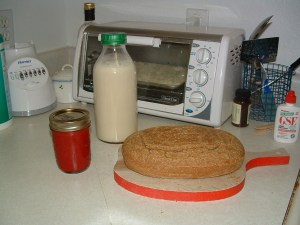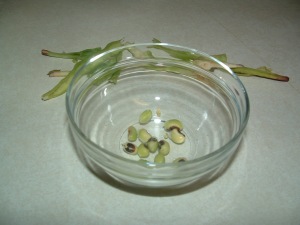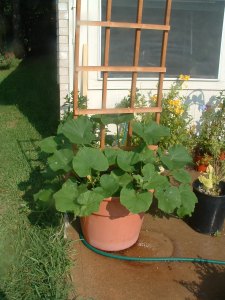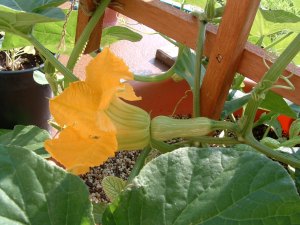
From left, strawberry jam, soymilk, quinoa-brown rice bread, with okara toasting in the toaster oven
I sit down tonight with a glass of merlot and say to you, “Salud!” And boyohboy, are my feet tired after a busy, busy day of prep work for my fall SFG installation and especially, doing a lot of experimental cooking, which is mainly what today’s blog is all about. It’s experimental, because I haven’t made most of this stuff before, and some of it is a little different than what most folks are used to.
So what did I make today? Well, first of all, I made some yummy, easy and organic strawberry freezer jam made with stevia instead of sugar. The Ball folks (ya know, the ones that make the Ball jars for homemade canning), have come out with pectin that you can use to make freezer jam that requires absolutely no cooking. You just crush yer fruit, toss the pectin with some sugar (and in my case, stevia), mix with the fruit, put it in some half-pint jars, let it set for 30 minutes et voila – fruit jam! No cooking fruit, no sterilizing jars in boiling water, nada of the sort.
Specifically, what I did was I bought three 10-oz bags of frozen organic strawberries. You can also get 4 lbs of strawberries, but even if ya don’t buy organic strawberries, it’s still more expensive than buying them frozen. Here in Austin, TX, you can go down to yer local HEB and buy organic frozen strawberries for $2.49 a bag, which is pretty dadgum good for organic frozen fruit. Mind you, next year I plan on growing my own strawberries and making jam from that, but for now, I gotta get them from HEB, or some other grocery store with organic strawberries. It’s still cheaper than buying organic strawberry jam (that has extra sugar), which costs between $3 and $4, depending on where you go. I made organic, sugar-free jam for $2.37 each for 4 jars of jam!
In any case, I let the frozen strawberries defrost in the fridge for a day, then I ground them up in my blender and put them in a bowl. Then I mixed the freezer-jam pectin with a teaspoon and a half of pure stevia powder, mixed that into the strawberries, ladled the stuff into 4 half-pint jars and let them sit for 30 minutes. EASY!
In case yer wondering what the heck is stevia, it’s an herb from South America that is very sweet, but has no calories, and no bad effects that chemical-based artificial sweeteners have, plus it helps balance blood sugar, which is helpful especially for diabetics. Read more about it at http://www.steviainfo.com/.
The next interesting thing I made was soymilk. Now, a few years ago, I thought the only way I could make soymilk at home was to buy a fairly expensive soymilk maker. I bought one, on sale for about 85 bucks or so. It worked great, but it was a bee-ach to clean. The filter inside it would get all clogged with little ground soybeans. Even with the special detergent the company that sold it provided, it was still challenging to make soymilk. I wound up not using the soymilk maker much, and finally sold it on Craigslist for 50 bucks back when I was a struggling graduate student and needed some money.
Well, turns out ya don’t need a fancy-dancy soymilk maker, and the clean up isn’t quite so bad, at least in my humble opinion. Here’s what ya do to make ya some good old fashioned homemade soymilk:
Soak 1 cup of organic soybeans 12-24 hours in at least 3 cups of water. Drain and rinse the soybeans after the soaking period. Put them in a blender with 4 cups of water, and blend until creamy. Then get you a big, deep pot and dump the soybean mixture into it and add 4 more cups of water.
Set the pot on the stove and turn the burner on high. Now, PAY ATTENTION! Keep yer eyes on the pot, because believe me, if ya don’t, that puppy is going to boil over, and yer going to have a big hairy mess on your hands (believe me, that’s what happened to me tonight — I didn’t pay attention and it boiled over, and I had a big friggin’ mess to clean up on my stove). Now, you do want it to boil almost to the point of boiling over, but not quite. When it gets to that point, turn the heat down to low and stir it til it goes down. Then turn the heat back to high, stand there and watch it, cuz it immediately will try to boil over again. When it does, turn the heat down to low again, stir til it goes down, then turn the heat back up to high, repeat, and repeat, and repeat, until it stops almost boiling over. It will take about 10 to 15 minutes to get to this point. If it doesn’t try to boil over for a couple of minutes while it’s on high heat, you are at this point. Then turn the heat to low and let it simmer, covered, for 10 minutes.
When this is complete, you need a colander with a metal screen and two layers of cheesecloth. I put this over the blender, and then I poured the milk through the cheesecloth and colander. What you are straining out is the soybean pulp, or okara, as it’s known in Japanese. You may want to put on rubber gloves to protect your hands from the hot pulp and squeeze some more milk out of the okara. I just took a spoon and pushed the okara with it to strain out extra milk.
Once you have strained out the milk, you can put it in a glass jar or bottle. I have a couple of actual glass milk bottles that I kept from some Promised Land milk I’d bought this summer when I needed some cow’s milk, and I put my freshly made soymilk into one of those glass bottles (cleaned in the dishwasher, of course!).
Now the next question is, wotta ya do with all that leftover soybean pulp? Well, first of all, fer heaven’s sake, don’t throw it out, or at least, if ya do, throw it out into yer compost pile, cuz it’s supposed to help make some really good compost! However, there are a jillion food items you can make with it. For more on what you can do with it, see http://ellenskitchen.com/clearlight/okara/okara.html and also, http://www.motherearthnews.com/Real-Food/1983-09-01/Okara-A-Meal-for-the-Asking.aspx and, one of my new favorite blogs, http://okaramountain.blogspot.com/. Just make sure that if you aren’t going to use it right away that you freeze it, because it is suppose to go bad fairly quick. And it’s probably best to toast it in the oven first to take out some of the moisture and then freeze it.
I’m experimenting with plain toasted okara, from which I can make any number of things, as well as the flavored toasted okara from the Ellen’s Kitchen site, which can be eaten like cereal. I plan also on making okara sausage patties and veggie patties, and using it in other ways as a cheap meat substitute. Apparently okara can be used much the same way TVP (texturized vegetable protein) can, but it’s much cheaper, and you have more control over how it is made, using organic, non-GMO soybeans. With a lot of TVP, you can’t usually get organic, and unless it says on the package, it probably isn’t non-GMO, and I just think that GMO products are pretty scary. Now that I know this about okara, and now that I’ve made soymilk, I’ll probably be making a lot more soymilk and okara-related food items. And I can get organic soybeans from Wheatsville for about 99 cents a pound, so I can have lots of cheap organic soymilk and okara meat substitutes!
The next wild thing I made tonight was quinoa-brown rice bread. It’s an interesting, gluten and wheat-free bread that tastes very similar to cornbread. Of course I love quinoa, and have used it often as a quick substitute for brown rice, as it cooks in about 10 to 15 minutes, and tastes (at least to me) much like brown rice. It’s the only grain that is a complete protein, and contains all the amino acids, plus it is also rich in iron and B-vitamins. It has been a staple in South American cooking for thousands of years, and was prized by the Incans who valued it for their warriors’ stamina. For more information, check out http://www.whfoods.com/genpage.php?tname=foodspice&dbid=142.
Anywho, I got the recipe for the quinoa-brown rice bread at http://pattycake.ca/recipes/quinoaricebread and didn’t vary it much except to use about ¼ tsp stevia powder, as opposed to agave. I think it turned out reasonably well. It is of course much flatter than wheat bread, but definitely tastes a lot like cornbread. It’s a great bread for those on gluten and wheat-free diets, and for those that don’t tolerate corn very well but love cornbread.
Well, that’s it for tonight’s blog segment. The next segment will likely be (though, no promises, it all depends on my mood, folks) on my fall SFG, where I’ll be planting lots of greens like kale, mustard greens, bok choy and spinach. Stay tuned!


